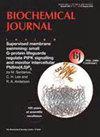Polyamination with spermidine enhances pathogenic tau conformations while reducing filamentous aggregate formation in vitro.
IF 4.3
3区 生物学
Q2 BIOCHEMISTRY & MOLECULAR BIOLOGY
引用次数: 0
Abstract
Tau is subject to a broad range of post-translational modifications (PTMs) that regulate its biological activity in health and disease, including microtubule (MT) dynamics, aggregation, and adoption of pathogenic conformations. The most studied PTMs of tau are phosphorylation and acetylation; however, the salience of other PTMs is not fully explored. Tissue transglutaminase (TG) is an enzyme whose activity is elevated in Alzheimer's disease (AD). TG action on tau may lead to intramolecular and intermolecular cross-linking along with the incorporation of cationic polyamines [e.g. spermidine (SPD)] onto glutamine residues (Q). Even though SPD levels are significantly elevated in AD, the effects of SPD polyamination on tau biology have yet to be examined. In this work, we describe a method to produce recombinant SPD-modified tau where SPD modifications are mainly localized to Q residues within the N-terminus. MT binding and polymerization assays showed that SPD modification does not significantly alter tau's binding to MTs but increases MT polymerization kinetics. In addition, biochemical and biophysical assays showed that SPD polyamination of tau markedly reduces tau polymerization into filamentous and β-sheet containing aggregates. On the other hand, SPD modification promotes the formation of pathogenic conformations (e.g. oligomerization and misfolding) by tau with or without inducing tau polymerization. Taken together, these data suggest that SPD polyamination of tau enhances its ability to polymerize microtubules and favors the adoption of pathogenic tau conformations but not filamentous aggregates in vitro.多胺化与亚精胺增强致病性tau构象,同时减少丝状聚集体的形成。
Tau蛋白受到广泛的翻译后修饰(PTMs)的影响,这些修饰调节其在健康和疾病中的生物活性,包括微管(MT)动力学、聚集和致病性构象的采用。研究最多的tau蛋白PTMs是磷酸化和乙酰化;然而,其他ptm的突出性尚未得到充分探讨。组织转谷氨酰胺酶(TG)是一种在阿尔茨海默病(AD)中活性升高的酶。TG对tau的作用可能导致分子内和分子间的交联,同时阳离子多胺[如亚精胺(SPD)]掺入到谷氨酰胺残基(Q)上。尽管SPD水平在AD中显著升高,但SPD多胺化对tau生物学的影响尚未得到研究。在这项工作中,我们描述了一种产生重组SPD修饰tau蛋白的方法,其中SPD修饰主要定位于n端内的Q残基。MT结合和聚合实验表明,SPD修饰不会显著改变tau与MT的结合,但会增加MT聚合动力学。此外,生化和生物物理实验表明,SPD多胺化显著减少tau聚合成丝状和含β片的聚集体。另一方面,SPD修饰通过tau蛋白促进致病构象的形成(如寡聚和错误折叠),无论是否诱导tau蛋白聚合。综上所述,这些数据表明,SPD多胺化tau增强了其聚合微管的能力,并有利于采用致病性tau构象,而不是丝状聚集体。
本文章由计算机程序翻译,如有差异,请以英文原文为准。
求助全文
约1分钟内获得全文
求助全文
来源期刊

Biochemical Journal
生物-生化与分子生物学
CiteScore
8.00
自引率
0.00%
发文量
255
审稿时长
1 months
期刊介绍:
Exploring the molecular mechanisms that underpin key biological processes, the Biochemical Journal is a leading bioscience journal publishing high-impact scientific research papers and reviews on the latest advances and new mechanistic concepts in the fields of biochemistry, cellular biosciences and molecular biology.
The Journal and its Editorial Board are committed to publishing work that provides a significant advance to current understanding or mechanistic insights; studies that go beyond observational work using in vitro and/or in vivo approaches are welcomed.
Painless publishing:
All papers undergo a rigorous peer review process; however, the Editorial Board is committed to ensuring that, if revisions are recommended, extra experiments not necessary to the paper will not be asked for.
Areas covered in the journal include:
Cell biology
Chemical biology
Energy processes
Gene expression and regulation
Mechanisms of disease
Metabolism
Molecular structure and function
Plant biology
Signalling
 求助内容:
求助内容: 应助结果提醒方式:
应助结果提醒方式:


